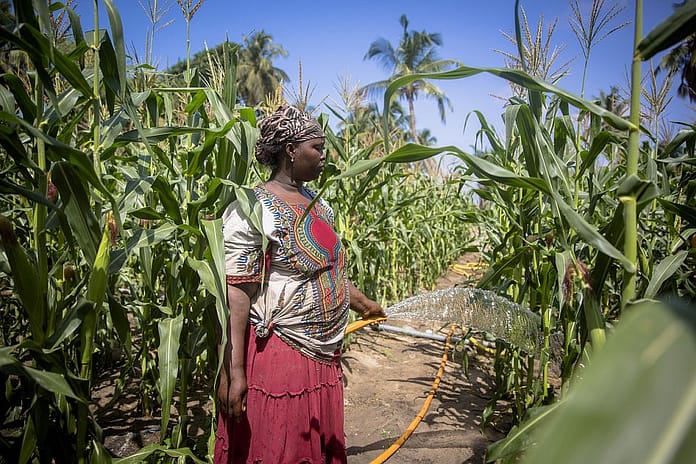By Matthew McCartney and Lisa-Maria Rebelo, IWMI
It is now widely accepted that nature-based solutions are an imperative in our fight against climate change and biodiversity loss, and central to our efforts to address many other global challenges as well. Recognition of nature-based solutions’ importance was achieved most recently at last November’s COP26 climate summit, with the resulting Glasgow Climate Pact emphasizing “the importance of protecting, conserving, and restoring nature and ecosystems…. as sinks and reservoirs of greenhouse gases and protecting biodiversity, while ensuring social and environmental safeguards.”

Wetlands are critical for both climate change mitigation and adaptation. Many types of wetlands — and in particular peatlands and blue carbon ecosystems such as sea grasses, mangroves, kelp beds, and tidal marshes — represent large stores of carbon that have been sequestered over long periods of time. For example, undisturbed peatlands (which cover over 3 million km2 globally) are estimated to sequester 0.37 gigatonnes of CO2 annually and store more than 600 gigatonnes of carbon, exceeding the carbon stored in all other vegetation types — including the world’s forests. Meanwhile, undisturbed coastal wetlands serve as powerful carbon sinks with carbon sequestration rates up to 55 times greater than tropical rainforests.
Despite their utility as carbon sinks, peatlands and blue carbon ecosystems can also be significant sources of greenhouse gases when disturbed. If peatlands and blue carbon wetlands are drained and degraded, for example, the majority of the carbon is released into the atmosphere (in the form of CO2, CH4, or other carbon species) within relatively few years. Emissions from drained peatlands alone are estimated to be the equivalent of 1.9 gigatonnes of CO2 annually, equal to 5% of global anthropogenic greenhouse gas emissions — a disproportionate amount considering degraded peatlands cover just 0.3% of the global landmass.
The recently released Global Wetland Outlook (GWO, 2021) emphasizes that embracing nature-based solutions — such as maintaining healthy wetlands that, in some environments, absorb seasonal floodwaters — can help society move beyond a narrow focus on human-built infrastructure. Indeed, freshwater wetlands are crucial components of the water cycle, as they represent terrestrial water stores that in some (though not all) contexts help strengthen water security and provide a buffer against hydrological extremes, such as floods and droughts.
Given wetlands’ promising potential to contribute to both climate mitigation and adaptation targets, IWMI and our partners recognize that preventing further degradation and loss of wetlands is absolutely critical as the effects of climate change become more severe around the globe. To that point, the 2021 Global Wetland Outlook asserts that while wetlands can be included in National Determined Contributions to climate mitigation efforts, accounting for wetlands’ carbon uptake and storage often requires further mapping of extent and location.

Safeguarding biodiversity and livelihoods
Because wetlands encompass a wide range of wet and dry ecological niches, they are typically hotspots for biodiversity. Indeed, it is estimated that 40% of all species live or breed in wetlands.
Crucially, wetlands also provide many other tangible and intangible benefits to large numbers of people living in their vicinity. For example, agriculture is commonly practiced in and around wetlands, with millions of hectares of wetland of various types supporting a wide range of agricultural activities.
Similarly, many wetlands are vital for fisheries that support the livelihoods of millions of small-scale fisher folk worldwide.
With wetlands under continued threat, the time to take action is now
Even with the multitude of benefits wetlands provide, these ecosystems are still being degraded throughout the world, lost as a consequence of inappropriate agricultural activities, urban development, and landscape degradation. The lack of awareness among government planners, natural resource managers, and local communities about the diverse benefits wetlands provide is one driving factor behind their degradation, as is the perceived need for short-term socio-economic development — even when such development efforts are achieved at the risk of undermining long-term sustainability.
Insufficient understanding of how nature-based solutions can be implemented also remains a major challenge. Indeed, too often the benefits that wetlands generate (known as ‘ecosystem services’) go unrecognized and unappreciated until those services are lost. And frequently, the impacts of degraded wetlands are felt most intensely by the poorest and most marginalized in society, who don’t have a voice in decision-making processes.
Going forward, more research is urgently needed to better understand both the types of challenges nature-based solutions can address and the contexts in which such solutions can be achieved. Greater research is also needed to explore not only the potential benefits and trade-offs associated with nature-based solutions, but also the drivers and mechanisms which are required to enable and support implementation and uptake. This is particularly the case for the Global South, where too few systematic wetland studies have been conducted, and even basic understanding derived from national wetland inventories is frequently lacking.
IWMI recognizes it will not be possible to protect global biodiversity, address climate change, hit net-zero targets, or achieve the UN Sustainable Development Goals (SDGs) without embracing nature-based solutions — a key element of which must be safeguarding and restoring the health of our global wetlands.
But time is of the essence. This World Wetlands Day and beyond, let’s commit to investing in nature-based solutions and the science needed to ensure that such investments enhance our ability to address global sustainability challenges, and secure meaningful progress toward achievement of the SDGs.
















